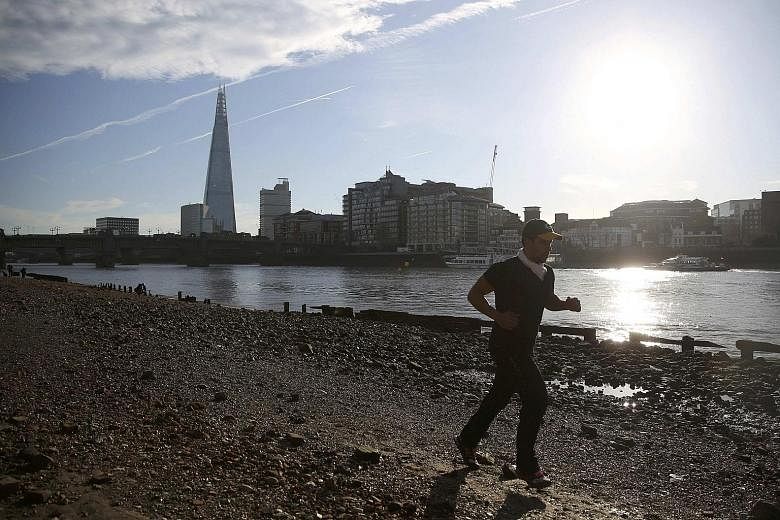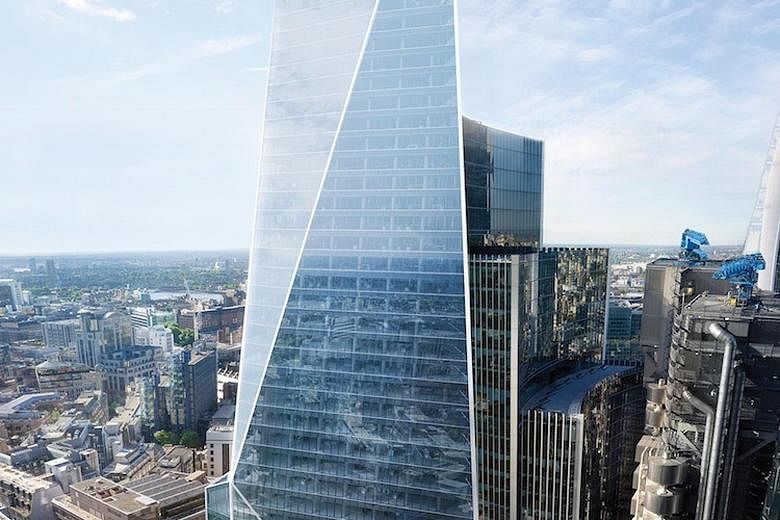The Shard towers over the south bank of the Thames, its 95-storey glass facade topped by futuristic spires perfect for clasping the evil eye of Lord Sauron, if he lived in London and not the fictional land of Mordor. But the capital's newest, tallest skyscraper will soon be one of many, joined by dozens of new structures vying to change London's skyline in the coming years.
According to think-tank New London Architecture (NLA), a total of 236 new buildings of 20 storeys and above are planned for London in the next decade. Add the fact that 55 of these new structures will measure 40 storeys or 132m and above, and it is easy to see why fears of a "Dubai-on-Thames" have been triggered among the populace of this 2,000-year-old city, renowned for fiercely protecting its heritage, traditions and crumbly, stone buildings no taller than the 111m-high St Paul's Cathedral.
"Yes, the London skyline is set to change dramatically," says Mr Chris Wilkinson, founder of architectural firm WilkinsonEyre, "...but this is only part of a gradual evolution since the Great Fire of London in 1666. Cities have to change to suit new requirements because nothing in life stays exactly the same."

Compared with cities worldwide, London, a world-class metropolis with first-rate facilities, is fairly late to the game of towers. In data collected by the Council on Tall Buildings and Urban Habitat, an independent research group, it currently ranks 43rd in the global skyscraper stakes - below cities like Singapore, Jakarta and Istanbul - with only 16 completed buildings measuring 150m and above.
Adding 55 tall buildings today will propel it to 11th place, just below Shenzhen. But it would still be dwarfed by Dubai, which is ranked third with 149 tall buildings.
Historically, London's lack of tall buildings has been attributed to its geology - it rests on shrinkable clay and not bedrock like Manhattan - and the hefty costs of fixing foundations on it. "Now," says Ms Roma Agrawal, a structural engineer who worked on the Shard, "we have the technology to drive concrete posts long and deep enough to hold the weight of skyscrapers".
Other key factors slowing construction include the city's planning laws, which preserve precious views of historical sites like St Paul's, the Tower of London and Westminster Palace from as far as Richmond Park, 16km away. And an embedded reflex for resisting modernisation: sometimes masquerading as heritage preservation and often led by a member of the royal family.
"Prince Charles was not the first royal to involve himself in the matter of tall buildings in London," says Mr Robert Matthews, senior architect at ColladoCollins. He explains that in the 1870s, a block of flats called Queen Anne's Mansions was built near Green Park. Queen Victoria objected to its height (14 storeys or about 46m) because it blocked her view of the Houses of Parliament from Buckingham Palace. "It resulted in the passing of the London Building Act 1894, restricting building heights to 80 feet (24m), and ended any possibility of a skyscraper boom in London," says Mr Matthews.
Mediaeval town planners and Christianity played a role too. From the 13th century until the late 19th century, the world's tallest buildings were always a church or cathedral - both to inspire townsfolk to look heavenwards and to demonstrate the Church's dominion over king and country.
London boasted about 100 churches in its Square Mile (financial district) before the 1666 fire destroyed 86 of them. Some 75 were rebuilt in the ensuing years, many by renowned architect Christopher Wren, including St Edmund The King and Martyr, St Mary Abchurch and the city's then highest structure, St Paul's Cathedral, which was completed in 1708.
Fast forward to 1986, when then Prime Minister Margaret Thatcher deregulated financial markets, attracted foreign banks and their dealing desks to London and fuelled demand for modern, open plan floor space. Top-down centralised city planning made way for pragmatism and growth. Canary Wharf was launched, spawning steel-and-glass office blocks like One Canada Square in 1991, London's first tower over 200m.
"Demands on the business district require larger buildings to suit new ways of working, which means many more tall buildings on the skyline. In London, it also means new skyscrapers rubbing shoulders with smaller historic buildings, but this is fine as long as the quality of architecture is maintained," says Mr Wilkinson.
-
SKYSCRAPERS IN THE WORKS
-
1 UNDERSHAFT, CITY OF LONDON
Nickname: Wondershaft
Height: 295m
Architect: Eric Parry
Use: Office
Ready: Seeking planning consent early this year
-
150 LEADENHALL STREET, CITY OF LONDON
Nickname: The Jenga Block
Height: 40 storeys (approx 132m)
Architect: WilkinsonEyre
Use: Office
Ready: 2018-2020
-
52-54 LIME STREET, CITY OF LONDON
Nickname: The Scalpel
Height: 192m
Architect: Kohn Pedersen Fox
Use: Office
Ready: Next year
-
ONE BLACKFRIARS ROAD, SOUTHWARK
Nickname: Boomerang
Height: 170m
Architect: Ian Simpson
Use: Residential
Ready: 2018
-
ONE NINE ELMS, VAUXHALL
Nickname: Two USB Sticks
Height: 200m
Architect: Kohn Pedersen Fox
Use: Mixed residential, office, retail
Ready: 2018
-
ONE MERCHANT SQUARE, PADDINGTON
Nickname: The Cucumber
Height: 150m
Architect: Robin Partington
Use: Residential, hotel
Ready: This year
In the last decade, Londoners have watched statement buildings mushroom and responded by calling them names. Their favourite, the "Gherkin" at 30 St Mary Axe, led the charge when it was completed in 2003. This Norman Foster-designed office space was soon followed by other "star architect" projects, including the Heron Tower at 110 Bishopsgate, the "Walkie Talkie" at 20 Fenchurch Street and the 224m-tall "Cheesegrater" (Leadenhall Building), its distinctive sloped wedge designed to protect views of St Paul's from the west. Other buildings set to join this cluster by 2019 are "The Jenga Block" at 150 Leadenhall Street, the "Can of Ham" at 60 St Mary Axe and the "Helter Skelter" at 22 Bishopsgate.
Meanwhile, the proposed 295m 1 Undershaft (already dubbed Wondershaft) plans to rival the Shard with a free viewing gallery at its peak. "The Shard has probably given people more confidence that we can create beautiful, sensitive-to-landscape skyscrapers," says Ms Agrawal.
It is somewhat apt that these towers of Mammon now loom over the dwindling, but still impressive, number of churches - 42 at last count - in the Square Mile, as modern day city-dwellers abandon faith to pursue wealth, success and a Victorian semi-detached in fashionable Islington. But heritage charity Friends of the City Churches is finding new ways to preserve this collection and keep their doors open, including recruiting volunteer "watchers", hosting book launches and luring the harried worker with artisan coffee in a quiet courtyard.
The latest rash of tall buildings to come, though, will not just house the money men. According to NLA, 80 per cent of the 236 new builds proposed will be for residential use. It says: "London will become the first city in Europe to be home to 10 million people by 2030; this means half a million new jobs and a million more people to be housed."
As a result, tall buildings are here to stay. "The centre of cities needs to stay close together," says Mr Wilkinson. "The alternative is urban sprawl and the consequential loss of identity." And Londoners, who already blame foreign buyers for snapping up luxury flats, sending up prices and driving the average family out of the city, will have these new towers to point their fingers at.
This also means the towers will spread beyond the City of London. "There's a wall of towers planned for the south side of the river from Battersea to Tower Bridge," says NLA. This includes the "Boomerang", a 50-storey residential block in One Blackfriars Road, its curved shape protecting views of the Shard, and developer Nine Elms' project in Vauxhall.
Will these changes alter the character of the city? Mr Matthews thinks not. "What makes a good city is not the skyline, but providing places where people can interact with one another. Many of the current tall buildings provide open space at ground level as a sort of compensation for building high. That's invaluable in a city like London," he says.
Many Londoners, and tourists probably, would like to have both options: to wander down a cobble-stoned alleyway lined with low, narrow, timber-framed shops, then take an ear-popping 30-second lift ride up a glass tower for the views.
The Dubai-on-Thames worriers, however, can rest easy: there won't be an 830m-tall Burj Khalifa replica in London. Any lofty ambitions are capped around 305m by the Civil Aviation Authority, to guard the airspace for planes approaching the city.




